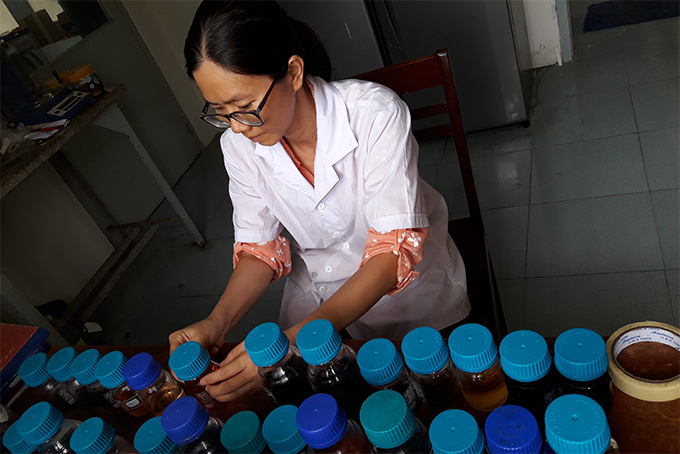
Nha Trang Institute of Technology Research and Application under the Vietnamese Academy of Science and Technology has just successfully extracted quinonoid pigment from sea urchins for the production of cosmetics...
Nha Trang Institute of Technology Research and Application under the Vietnamese Academy of Science and Technology has just successfully extracted quinonoid pigment from sea urchins for the production of cosmetics.
According to PhD. Vo Mai Nhu Hieu (Nha Trang Institute of Technology Research and Application), the director of the research on the application of the natural quinonoid pigment from sea urchins in Khanh Hoa Province in producing cosmetics, sea urchins are rich in nutrients. and the quinonoid, their unique value in the production of cosmetics, is still unknown to many people.
Meanwhile, the material of sea urchins has not been thoroughly studied in Vietnam. Their hard shells and thorns, making up 40 - 70% of the weight, are normally thrown away. Therefore, the research on extracting the natural quinonoid pigment from sea urchins in Khanh Hoa aims to find materials for high-value pharmaceutical products. This is also a basis for orienting exploitation, farming and rational use of sea urchin resources. The research has set a goal to build a process of extracting the quinonoid from sea urchin shells; and the laboratory-scale process of producing quinonoid-containing cosmetics.

|
After 4 years of implementation, in September 2021, the research was examined and approved. The innovative study has built a process of extracting quinonoid from Diadema setosum with a scale of 1kg of material/ batch. The quinonoid from 4 kinds of sea urchins, namely Diadema savignyi, Diadema setosum, Stomopneustes variolaris and Tripneustes gratilla in Khanh Hoa is equivalent to Spinochrome E (14%, 6%, 26%, 72%), Echinochrome A (59%, 87%, 73%), Spinochrome D (8%) from Diadema savignyi; Spinochrome A (26%) from Tripneustes gratilla, which may be used to produce cosmetic ingredients.
The researchers have developed a cosmetic cream formula and a process to make cosmetic ingredients containing quinonoid from the shell of sea urchins (0.2kg/batch) in Khanh Hoa. The quinonoid extracted from the 4 types of sea urchins mentioned above has significant antioxidant and tyrosinase inhibition properties.
The research has graded excellent at the academic level due to its scientific basis and elaborateness. The cream containing quinonoid pigment has significant antioxidant and tyrosinase inhibition properties without skin allergies. The research has created a basis for producing cosmetics containing sea urchin-derived quinonoid. This kind of new natural ingredient promises to promote high-value cosmetics made in Vietnam, according to According to PhD. Pham Duc Thinh, Director of Nha Trang Institute of Technology Research and Application, Chairman of the Science Council.
V.L
Translated by N.T






